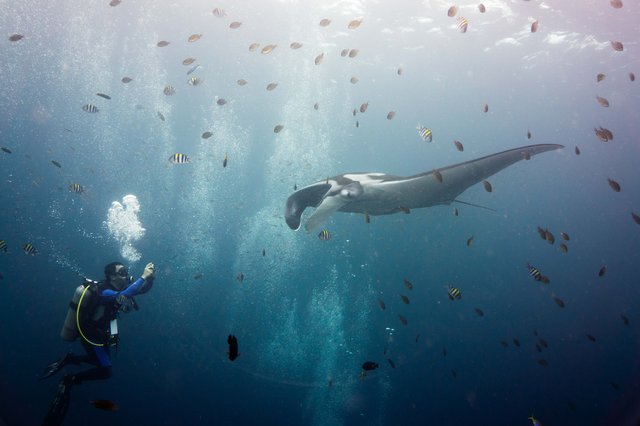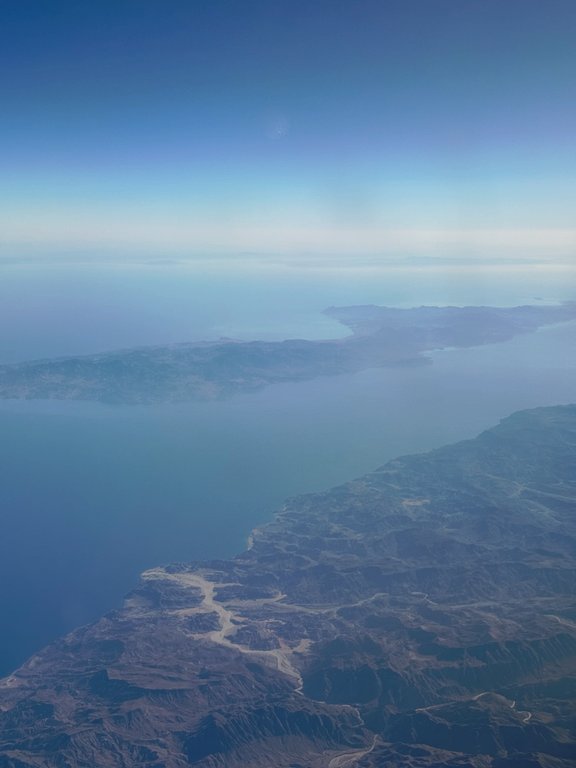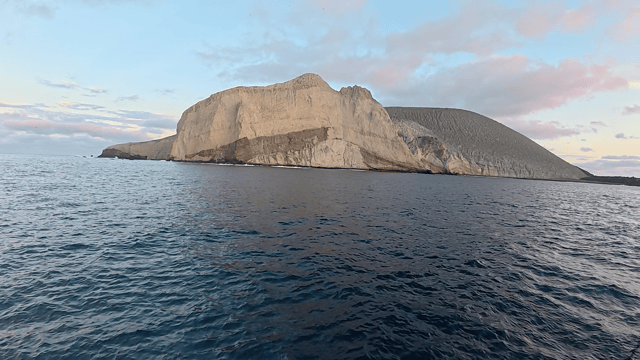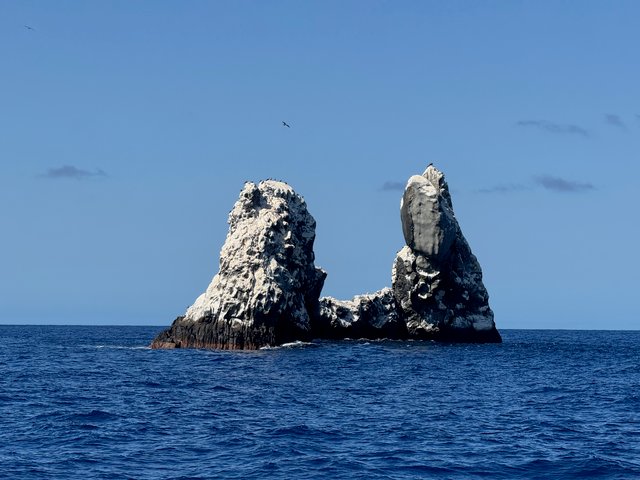Diving in Socorro
-- 1350 WordsDiving,
This year I got into diving, with a primary goal being to dive with Giant Oceanic Manta Rays. There are a few places in the world where you can reliably see these animals, and one of the most highly rated is Socorro Island, Mexico. I booked a trip with Nautilus, a liveaboard dive boat operator that is considered one of the best in the region. The trip was nine days in total, with five days of planned diving. It ended up being a really incredible adventure that I’d like to share here.

The Revillagigedo Archipelago is a volcanic island chain located in the Pacific Ocean, about 220 miles southwest of Cabo San Lucas. The largest island in the chain is Socorro island, and the destination is often referred to simply as “Socorro”. The islands are a designated UNESCO World Heritage site and marine reserve, and home to an enormous variety of pelagic marine life. With the exception of a small Mexican Navy outpost, they are uninhabited, and only visited by a few dozen divers each week on a handful of liveaboard boats.
The main attraction is the Giant Oceanic Manta Ray (pictured above), which can have a wingspan of up to 23 feet and weight up to 6,600 pounds. In addition, there are a plethora of Shark species, including Silvertip, Silky, Galapagos, Hammerhead, and Tiger. It’s also possible to see Dolphins, and in rare cases Humpback whales and Whale Sharks.
Getting There

The boat is relatively small at 105 ft, and we had 15 divers and 8 crew. From Cabo San Lucas, it takes about 30 hours to reach the archipelago. Since the crossing is in the open Pacific Ocean, it can be quite rough, but we were met with very calm seas, and seasickness was manageable.
Daily Schedule
Each day we would plan to have four dives, making for a pretty tight schedule which was roughly as follows:
- 6:00 AM - Wake up
- 6:15 AM - Continental breakfast
- 6:40 AM - Dive briefing
- 7:00 AM - First dive
- 9:00 AM - Hot breakfast
- 11:00 AM - Second dive
- 12:00 PM - Lunch
- 13:00 PM - Third dive
- 16:00 PM - Fourth dive
- 19:00 PM - Dinner
Each dive was between 30 and 45 minutes depending on your air consumption, and we dove in the range of 60-85 feet. With the exception of the first day, we entered / exited the water from a Zodiac-style skiff. The water temperature was 75-77 degrees Fahrenheit, and most people were comfortable in a 5mm wetsuit.
Everything felt very well orchestrated, each dive had a clear dive plan and we followed a specific procedure for boarding the skiff, entering the water, and surfacing. A concern I had ahead of time was getting easily lost given the presence of strong currents in certain sites, but I found that it was easy to stick together and every time we surfaced there was a skiff waiting to pick us up (they looked out for our surface marker buoys (SMBs)).
Diving Day 1: San Benedicto (Fondeadero and El Cañon)
San Benedicto is an uninhabited island which experienced a volcanic eruption in 1952 and has little vegetation to this day. It is, however the host of a number popular dive sites and we spent two days total diving here.

For our first day we did easy dives to allow everyone to get comfortable with the gear and procedures, and adjust their buoyancy. Despite these being checkout dives, they did not disappoint: we saw several Manta Rays within just a few minutes of entering the water.
The first dive was at Fondeadero (Anchorage), and was a shallow(er) dive with a sandy bottom. For this dive, we dove off the back of the boat, and descended on a line to about 30 ft before continuing to the bottom around 65 ft. The visibility was about 60 ft and there was a moderate current. Before we even reached the bottom, we saw a Manta Ray, and ended up spending most of the dive with three individuals.
One of the things that distinguishes Socorro is how friendly the Manta Rays are. There is no need to approach them, they will swim right up to groups of divers, and either dance around in the bubbles or even swim by to make eye contact as you see above. In addition to the Mantas, we saw a one or two White Tip Reef Sharks, and a variety of fish.
For the remaining three dives, we moved to diving off the skiffs at El Cañon (The Canyon). This site is a bit deeper, and has a large cleaning station where we spent most of our time. The current was a bit stronger here and unfortunately we had to swim in it most of the time, but we saw an amazing variety of sharks, and more Mantas.
The cleaning station had an incredible density and and diversity of life.
On a few occasions we were able to catch a glimpse of the shy Hammerhead sharks in the distance.
Even our safety stops were interesting, as we floated in a blue void with the occasional large fish passing by.
Diving Day 2: Roca Partida

Roca Partida is a very pointy rock formation that rises up from great depths below. The exposed rock is quite small and home to only birds. Underwater the formation is steep enough that it is essentially a wall dive.
This dive site was filled with Sharks, many of whom were piled up on the ledges and accompanied by enormous lobsters.
We saw a few Manta Rays, who kept their distance this time, but one showed off some amazing acrobatics.
The real highlight of the day though, was a Whale Shark, which swam by us twice at a distance as it orbited the rock. If you look carefully you can see a relatively large White Tip or Silver Tip shark following it in the bottom left corner, giving some idea of the scale. Probably at least 30 ft long!
Diving Day 3: Cabo Pearce
Cabo Pearce is a finger-shaped lava flow that extends from the eastern side of Socorro Island. It continues for a long distance under water and this area makes for a fantastic dive site. We spent most of our time around an area called the “Amphitheater”, which offered some shelter from the current. The first dives were quiet, with the occasional Manta or Hammerhead swimming by at a distance.
Pretty soon though, several individuals showed up and began to swim playfully with each other and the divers.
On one occasion, I got a great video of a Manta articulating its cephalic fins, which is thought to be used for communication.
We also saw some interesting fish including Tuna and this curious Wahoo during our safety stop.
Diving Day 4: San Benedicto (El Boiler)
Our final day of diving was back at San Benedicto at the famous El Boiler (The Boiler) site. The Boiler is an underwater seamount that rises up from a floor of about 130 ft to within 15 ft of the surface where it forms roiling water which gives it its name.
Early in the day, we were visited briefly by a pod of Dolphins including a mother and calf.
It was not long though before the Manta Rays showed up in large numbers. I counted 6 or 7 individuals at one time, as they again displayed amazing agility.
Wrap Up
All of my footage was shot on a DJI Osmo Action 5 which I selected for its low light performance. I think it performed pretty well, any color grading issues are from my own inexperience during post-processing.
This trip was a fantastic experience. The crew of the Nautilus UnderSea were excellent, clearly very passionate about diving and marine life, and very patient with a variety of diver experience levels. Socorro island is a very unique place for its density and diversity of pelagic marine life.